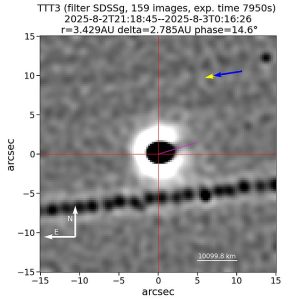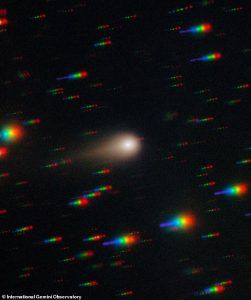Interstellar Visitor 3I/ATLAS Defies Physics with Mysterious Sunward Jet
The interstellar object 3I/ATLAS is exhibiting unprecedented behavior that has scientists questioning its true nature. A mysterious jet pointing toward the Sun—directly opposite to how normal comet tails behave—has created a major astronomical puzzle.
Key Takeaways
- 3I/ATLAS displays a sunward-pointing jet, contradicting normal comet physics
- Harvard professor Avi Loeb suggests 30-40% chance of non-natural origin
- Critical observations planned during October 29 solar close approach
- ESA’s Juice spacecraft will monitor object from 125 million miles
The Anomalous Sunward Jet
In August, the Two-Meter Twin Telescope in the Canary Islands captured a faint jet extending approximately 3.7 miles from the object’s nucleus, pointing directly toward the Sun. This contradicts fundamental comet physics, where solar radiation typically pushes tails away from the Sun.
Harvard professor Avi Loeb stated: ‘The existence of an anti-tail pointed toward the sun is an anomaly that raises two questions: What is the nature of the anti-tail? Why are comet experts ignoring this anomaly while insisting that 3I/ATLAS is a familiar comet?’
Hubble Confirms Unusual Pattern
Weeks earlier, the Hubble Space Telescope observed a similar phenomenon—an extended glow aimed sunward in late July. Loeb described the glow as stretching roughly ten times longer than wide, forming a jet geometry ‘unlike any known comet.’
‘Realizing this is as shocking as photographing an animal your family thinks is a street cat, only to see a tail coming out of its forehead,’ Loeb said.
Both Hubble and ground-based observations confirm material moving toward the Sun, defying conventional comet behavior. Loeb suggests the orientation could indicate ejection of heavy particles less affected by sunlight, or an entirely new outgassing mechanism.
Alien Origin Theory
Loeb has speculated about extraterrestrial origins, estimating a 30-40% chance the object ‘does not have a fully natural origin.’ He raised the possibility of a ‘Trojan Horse’ scenario where a technological object masquerades as a comet.
However, NASA maintains the object is a natural comet, releasing images showing its cylindrical shape as it passed Mars on October 3. Social media stargazers shared color-enhanced images revealing a green glow.
Critical Solar Approach
The mystery may resolve when 3I/ATLAS makes its closest solar approach on October 29. According to Loeb, the object should ‘disintegrate into fragments’ if it’s a natural comet.
‘When a comet gets close to the sun, solar radiation heats its icy nucleus,’ Loeb explained. ‘Volatile ices like carbon dioxide, carbon monoxide, or water sublimate directly into gas, carrying away dust and small rocks.’ This process can cause structural failure under thermal stress.
International Monitoring Campaign
The European Space Agency’s Jupiter Icy Moons Explorer (Juice) will have a front-row view from 125 million miles, monitoring through November. Loeb speculated the craft might capture either disintegration or the release of ‘mini-probes as a technological mothership.’
Terrestrial observatories will monitor during November and December to determine whether 3I/ATLAS disintegrates like a natural comet or exhibits artificial characteristics. The object will appear as a fuzzy ball of light, potentially breaking into independent smaller dots if it fragments.
Scientists worldwide await these observations, which could finally resolve whether we’re witnessing natural phenomena or something more extraordinary.






